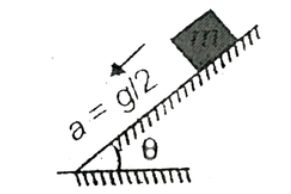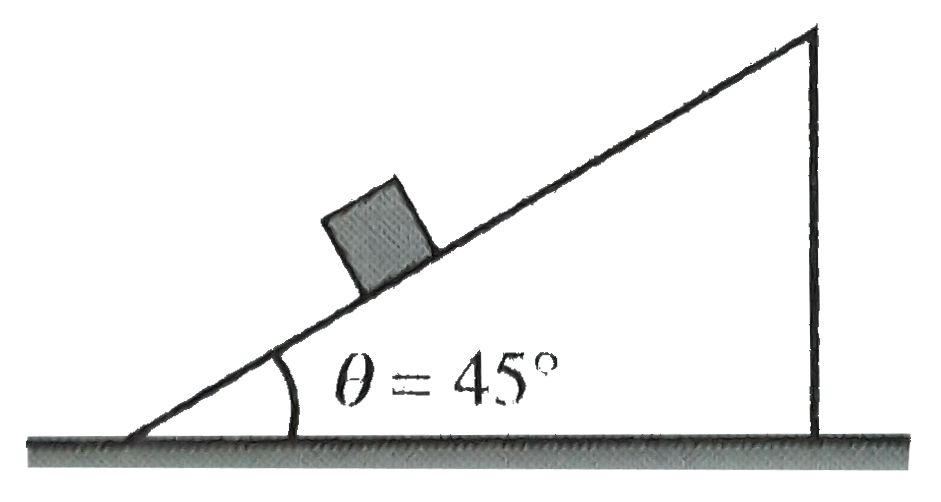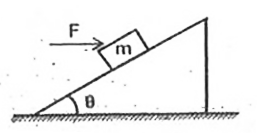A cubical block of mass M and edge a slides down a rougg inclined plane of inclination θ with a uniform velocity. The torque of the normal force on the block about its centre has magnitude.
The correct Answer is:A, B
To solve the problem of finding the torque of the normal force on a cubical block sliding down a rough inclined plane, we can follow these steps:
1. Identify the Forces Acting on the Block:
- The forces acting on the block are its weight (mg), the normal force (N), and the frictional force (F). The weight can be resolved into two components: one parallel to the incline (mg sin θ) and one perpendicular to the incline (mg cos θ).
2. Understand the Condition of Uniform Velocity:
- Since the block is sliding down with uniform velocity, the net force acting along the incline is zero. This means that the frictional force (F) must balance the component of the gravitational force acting down the incline:
F=mgsinθ
3. Determine the Torque Due to the Frictional Force:
- The torque (τ) due to the frictional force about the center of mass of the block can be calculated. The frictional force acts at the bottom edge of the block, which is at a distance of a2 from the center of mass. Therefore, the torque due to friction is:
τfriction=F⋅a2
- Substituting the expression for frictional force:
τfriction=(mgsinθ)⋅a2
4. Analyze the Torque Due to the Normal Force:
- The normal force acts perpendicular to the surface of the incline. The distance from the center of mass to the line of action of the normal force is also x, which we need to find. However, since the block is in equilibrium (uniform velocity), the net torque about the center of mass must be zero:
τnormal+τfriction=0
- Therefore, we can express the torque due to the normal force as:
τnormal=−τfriction
5. Calculate the Magnitude of the Torque of the Normal Force:
- Since we have established that the torque due to the normal force balances the torque due to friction, we can write:
τnormal=−(mgsinθ⋅a2)
- The magnitude of the torque of the normal force about the center of mass is:
|τnormal|=mgsinθ⋅a2
Final Answer
The magnitude of the torque of the normal force on the block about its center is:
|τnormal|=mgsinθ⋅a2
- The forces acting on the block are its weight (mg), the normal force (N), and the frictional force (F). The weight can be resolved into two components: one parallel to the incline (mg sin θ) and one perpendicular to the incline (mg cos θ).
- Since the block is sliding down with uniform velocity, the net force acting along the incline is zero. This means that the frictional force (F) must balance the component of the gravitational force acting down the incline:
F=mgsinθ
- The torque (τ) due to the frictional force about the center of mass of the block can be calculated. The frictional force acts at the bottom edge of the block, which is at a distance of a2 from the center of mass. Therefore, the torque due to friction is:
τfriction=F⋅a2
- Substituting the expression for frictional force:
τfriction=(mgsinθ)⋅a2
- The normal force acts perpendicular to the surface of the incline. The distance from the center of mass to the line of action of the normal force is also x, which we need to find. However, since the block is in equilibrium (uniform velocity), the net torque about the center of mass must be zero:
τnormal+τfriction=0
- Therefore, we can express the torque due to the normal force as:
τnormal=−τfriction
- Since we have established that the torque due to the normal force balances the torque due to friction, we can write:
τnormal=−(mgsinθ⋅a2)
- The magnitude of the torque of the normal force about the center of mass is:
|τnormal|=mgsinθ⋅a2
The magnitude of the torque of the normal force on the block about its center is:
|τnormal|=mgsinθ⋅a2
Topper's Solved these Questions
- BOOK - HC VERMA ENGLISHCHAPTER - ROTATIONAL MECHANICSEXERCISE - Questions for short Answer21videos
ROTATIONAL MECHANICS
- BOOK - HC VERMA ENGLISHCHAPTER - ROTATIONAL MECHANICSEXERCISE - Objective -214videos
ROTATIONAL MECHANICS
- BOOK - HC VERMA ENGLISHCHAPTER - REST AND MOTION : KINEMATICSEXERCISE - Question for short Answer13videos
REST AND MOTION : KINEMATICS
- BOOK - HC VERMA ENGLISHCHAPTER - SIMPLE HARMONIC MOTIONEXERCISE - Question for short Answer15videos
SIMPLE HARMONIC MOTION
Similar Questions
A block of mass m slides down a rough inclined plane with an acceleration g2
 View Solution
View SolutionA block of mass m is placed on a smooth inclined plane of inclination θ with the horizontal. The force exerted by the plane on the block has a magnitude
View SolutionA block of mass m is placed on a smooth inclined plane of inclination θ with the horizontal. The force exerted by the plane on the block has a magnitude
View SolutionA block of mass m slides down an inclined plane of inclination θ with uniform speed. The coefficient of friction between the block and the plane is μ. The contact force between the block and the plane is
View SolutionA block of mass 250 g slides down an incline of inclination 370 with a uniform speed. Find the work done against the friction as the block slides through 1.0 m.
View SolutionA block of mass m=3kg slides on a rough inclined plane of cofficient of friction 0.2 Find the resultant force offered by the plane on the block
 View Solution
View SolutionA small block of mass m is kept on a rough inclined surface of inclination θ fixed in an elevator. The elevator goes up with a uniform velocity v and the block does not slide on the wedge. The work done by the force of friction on the block in time t will be
View SolutionA block of mass m moves with constant speed down the inclined plane of inclination θ. Find the coefficient of kinetic friction.
 View Solution
View SolutionA block of mass 5.0 kg slides down an incline of inclination 300 and length 10 m. find the work done by the force of gravity.
View SolutionA body is placed on a rough inclined plane of inclination θ. As the angle θ is the increased from 0∘ to 90∘, the normal force between the block and the plane is,
 View Solution
View Solution

